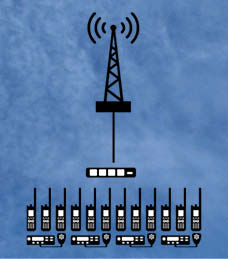Exploring Trunked Two-Way Radio Systems: A Comprehensive Guide
Learn about the basics of radio system trunking in this blog post.

In the realm of modern communication, staying connected and informed is crucial, especially in environments where real-time communication can make all the difference. Trunked two-way radio systems have emerged as an essential tool for organizations and industries that rely on efficient and seamless communication. In this blog post, we'll delve into the basics of trunked two-way radio systems, uncovering what they are and how they work.
Understanding Trunked Two-Way Radio Systems
At its core, a trunked two-way radio system is a sophisticated communication network designed to:
- handle a large number of users and groups
- and efficiently manage the limited frequency spectrum available for radio communication
Unlike traditional radio systems that rely on a fixed set of frequencies, trunked systems dynamically allocate frequencies based on demand, ensuring optimal channel utilization and minimizing communication conflicts. You can see a diagram of a trunked two-way radio system on page 2 of this document.
How Trunked Two-Way Radio Systems Work
-
Dynamic Channel Allocation: The defining feature of trunked systems is their ability to dynamically allocate channels for communication. In traditional systems, users would each have a dedicated frequency, leading to frequency congestion when many users are communicating simultaneously. Trunked systems solve this problem by pooling a set of frequencies into a common resource which is managed by a central control channel.
-
Talkgroups and Users: In a trunked system, users are organized into talkgroups, which are essentially virtual channels or communication groups. Instead of manually selecting a frequency like in conventional systems, users select a talkgroup to join. The central controller then assigns an available frequency to that talkgroup, ensuring that multiple groups can use the same set of frequencies without interfering with each other.
-
Central Controller: The heart of a trunked two-way radio system is the central controller. This device manages the allocation of frequencies, monitors the status of talkgroups, and ensures that communication is seamless. The central controller keeps track of which frequencies are in use and which talkgroups are active, making real-time decisions to assign and release frequencies as needed.
-
Frequency Hopping: To further optimize communication and reduce interference, many trunked systems use frequency hopping. This technique involves rapidly switching between a predefined set of frequencies within a talkgroup. This helps overcome signal interference and enhances the security of communication.
Benefits of Trunked Two-Way Radio Systems
- Efficient Spectrum Utilization: By dynamically allocating frequencies, trunked systems make the most of the available frequency spectrum, avoiding congestion and ensuring reliable communication.
- Enhanced Capacity: Trunked systems can support a much larger number of users and talkgroups than conventional radio systems, making them suitable for organizations with high communication demands, such as public safety agencies, transportation, and large industrial facilities.
- Flexibility: Users can easily switch between talkgroups as their communication needs change, without manually adjusting frequencies.
- Security: Frequency hopping and centralized control add an extra layer of security to communication, reducing the risk of eavesdropping and unauthorized access.
- Scalability: Trunked systems are scalable, allowing organizations to add more users and talkgroups as their communication requirements grow.
Types of Motorola Solutions MOTOTRBO Trunking Systems

The most commonly used trunking systems are MOTOTRBO systems. These include:
- Capacity Plus: Single-site, non-controller-based trunking
- Capacity Plus Multi-Site: Multi-site, non-controller-based trunking
- Connect Plus: Multi-site or single-site, controller-based trunking (discontinued)
- Capacity Max: Multi-site or single-site, controller-based trunking (watch Capacity Max video here)
Trunked two-way radio systems have revolutionized communication by introducing dynamic channel allocation and efficient frequency management. These systems offer significant advantages in terms of capacity, flexibility, and security, making them indispensable tools for industries that rely on swift and reliable communication. Whether it's coordinating emergency responses, managing transportation logistics, or facilitating large-scale events, trunked two-way radio systems play a crucial role in keeping organizations connected and informed.
Contact us to find out which system is right for you!
